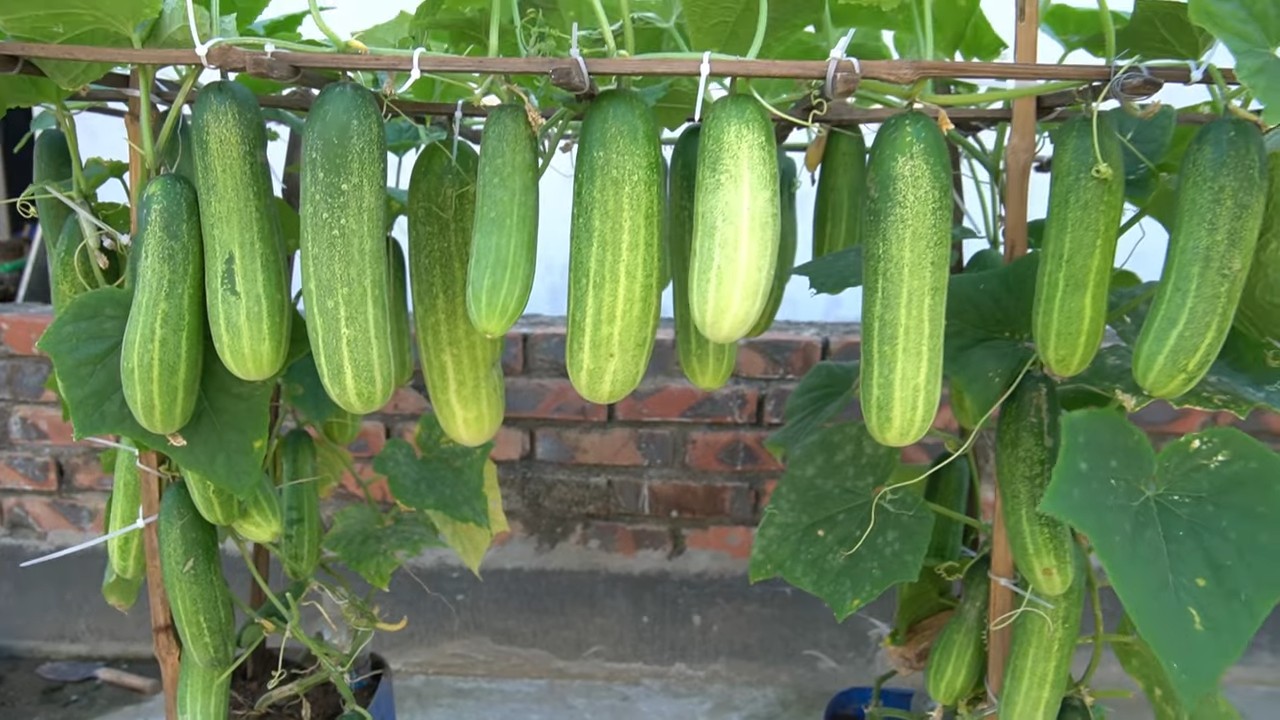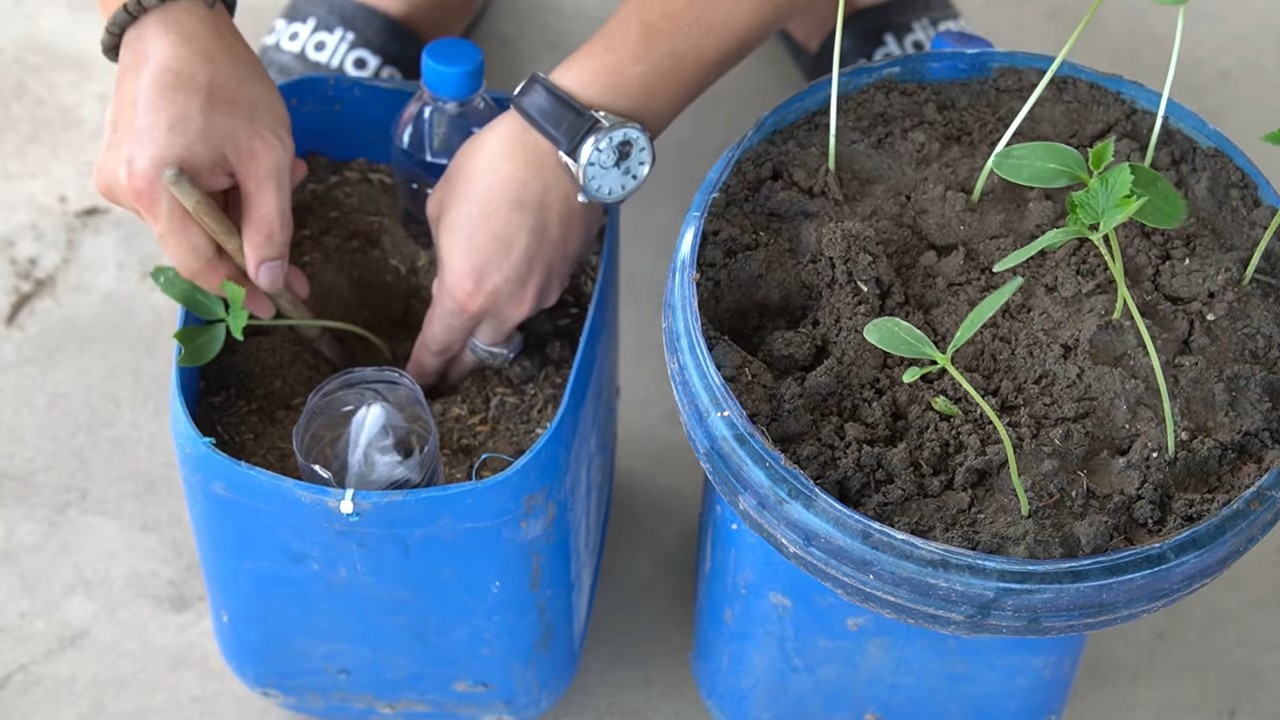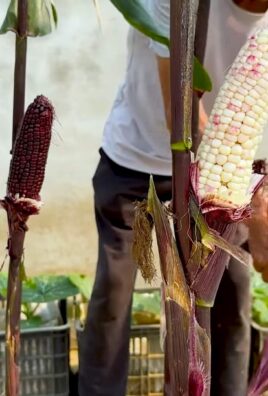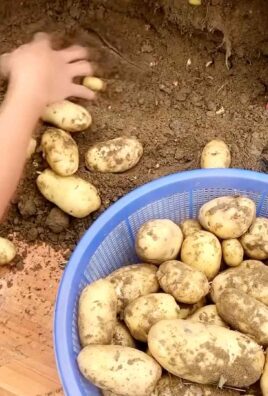Container cucumbers! The very words conjure images of crisp, refreshing salads and tangy homemade pickles, don’t they? But the thought of growing your own cucumbers might seem daunting, especially if you’re short on space. Fear not, fellow gardening enthusiasts! This beginner’s guide is your key to unlocking a bountiful harvest of delicious cucumbers, even if all you have is a balcony or a sunny patio.
Growing cucumbers in containers isn’t a new fad. In fact, container gardening has been practiced for centuries, with evidence suggesting its roots in ancient civilizations like Egypt and Rome. These resourceful gardeners utilized pots and vessels to cultivate plants in limited spaces, bringing beauty and sustenance closer to home. Today, we’re carrying on that tradition, adapting it to modern lifestyles and urban environments.
Why should you embark on this container cucumber adventure? Well, besides the sheer joy of nurturing life and harvesting your own food, growing cucumbers in containers offers several advantages. It’s a fantastic way to control the growing environment, protect your plants from pests and diseases, and maximize your yield in a small area. Plus, there’s nothing quite like the taste of a freshly picked cucumber, bursting with flavor and grown with your own two hands. I’m excited to share my tips and tricks to help you succeed with container cucumbers!

Growing Cucumbers in Containers: A Beginner’s Guide
Hey there, fellow gardening enthusiasts! I’m so excited to share my experience with growing cucumbers in containers. It’s a fantastic way to enjoy fresh, homegrown cucumbers even if you don’t have a sprawling garden. Trust me, with a little know-how, you can have a thriving cucumber patch right on your balcony or patio. Let’s dive in!
Choosing the Right Cucumber Variety
Not all cucumbers are created equal, especially when it comes to container gardening. You’ll want to pick varieties that are compact and bush-like, rather than those that vine aggressively. Here are a few of my favorites:
* Bush Champion: This variety is specifically bred for containers and produces a good yield of standard-sized cucumbers.
* Spacemaster: As the name suggests, Spacemaster is perfect for small spaces. It produces dark green, 7-8 inch fruits.
* Patio Snacker: This is a great choice for snacking cucumbers. The fruits are small, crisp, and perfect for salads or eating fresh.
* Picklebush: If you love pickles, this is the cucumber for you! It’s a compact bush variety that produces plenty of pickling-sized cucumbers.
* Little Leaf: This variety is known for its smaller leaves, which allows for better air circulation and reduces the risk of disease.
Gathering Your Supplies
Before we get started, let’s make sure you have everything you need. Here’s a checklist:
* Container: Choose a container that’s at least 12 inches in diameter and 12 inches deep. The bigger, the better, as cucumbers need plenty of room for their roots to grow. A 5-gallon bucket or a large planter works perfectly.
* Potting Mix: Don’t use garden soil! It’s too heavy and doesn’t drain well in containers. Opt for a high-quality potting mix that’s lightweight and well-draining.
* Cucumber Seeds or Seedlings: Select your preferred cucumber variety. You can start from seeds or buy seedlings from a local nursery.
* Trellis or Support: Even bush varieties benefit from some support. A small trellis, tomato cage, or even a sturdy stake will help keep the plants upright and prevent the fruits from sitting on the soil.
* Fertilizer: A balanced, slow-release fertilizer is ideal for feeding your cucumber plants. You can also use a liquid fertilizer every few weeks.
* Watering Can or Hose: Cucumbers need consistent moisture, so make sure you have a reliable way to water them.
* Gardening Gloves: Protect your hands from dirt and potential irritants.
* Hand Trowel: For planting and transplanting.
Planting Your Cucumbers
Now for the fun part! Let’s get those cucumbers planted.
Starting from Seeds:
1. Prepare the Container: Fill your container with potting mix, leaving about an inch or two of space at the top.
2. Sow the Seeds: Make small holes about 1 inch deep and 2-3 inches apart. Place 2-3 seeds in each hole. This ensures at least one seed will germinate.
3. Cover and Water: Gently cover the seeds with potting mix and water thoroughly.
4. Provide Warmth: Cucumber seeds germinate best in warm soil (around 70-80°F). If it’s still cool outside, you can place the container in a warm, sunny spot indoors or use a heat mat.
5. Thin Seedlings: Once the seedlings emerge (usually in 7-10 days), thin them to one strong seedling per hole. Snip off the weaker seedlings at the soil line to avoid disturbing the roots of the remaining plant.
Transplanting Seedlings:
1. Prepare the Container: Fill your container with potting mix, leaving about an inch or two of space at the top.
2. Dig a Hole: Dig a hole in the center of the container that’s large enough to accommodate the root ball of the seedling.
3. Remove the Seedling: Gently remove the seedling from its nursery pot. If the roots are tightly bound, gently loosen them with your fingers.
4. Plant the Seedling: Place the seedling in the hole, making sure the top of the root ball is level with the surrounding soil.
5. Fill and Water: Fill in the hole with potting mix and gently pat it down. Water thoroughly.
Providing Support
Cucumbers, even bush varieties, benefit from some support to keep them off the ground and improve air circulation.
1. Install the Trellis or Support: Insert your trellis, tomato cage, or stake into the container near the cucumber plant. Do this early on to avoid damaging the roots later.
2. Train the Plant: As the cucumber plant grows, gently guide the stems towards the support and tie them loosely with soft twine or plant ties. You may need to do this every few days.
Caring for Your Cucumber Plants
Consistent care is key to a bountiful cucumber harvest.
Watering:
Cucumbers need consistent moisture, especially during hot weather. Water deeply whenever the top inch of soil feels dry to the touch. Avoid overhead watering, as this can lead to fungal diseases. Aim to water at the base of the plant. I usually water mine every morning during the summer.
Fertilizing:
Feed your cucumber plants regularly with a balanced fertilizer. If you used a slow-release fertilizer at planting time, you may only need to supplement with a liquid fertilizer every few weeks. Otherwise, fertilize every 2-3 weeks. Look for a fertilizer with a higher potassium content, as this promotes fruit production.
Sunlight:
Cucumbers need at least 6-8 hours of sunlight per day. Place your container in a sunny location where it will receive plenty of direct sunlight. If you live in a very hot climate, some afternoon shade can be beneficial.
Pollination:
Cucumbers are typically pollinated by bees and other insects. If you’re growing cucumbers indoors or in an area with limited pollinators, you may need to hand-pollinate them. To do this, use a small paintbrush to transfer pollen from the male flowers (which have a long, thin stem) to the female flowers (which have a small cucumber-like fruit at the base).
Pruning:
While not always necessary, pruning can help improve air circulation and encourage fruit production. Remove any yellowing or dead leaves, as well as any suckers (small shoots that grow from the base of the plant).
Dealing with Pests and Diseases
Even in containers, cucumbers can be susceptible to pests and diseases. Here are a few common problems and how to deal with them:
* Aphids: These tiny insects can suck the sap from cucumber leaves, causing them to curl and distort. You can control aphids by spraying them with a strong stream of water, using insecticidal soap, or introducing beneficial insects like ladybugs.
* Spider Mites: These tiny pests create webs on the undersides of leaves and can cause the leaves to turn yellow and stipple. Control spider mites by spraying them with a strong stream of water, using insecticidal soap, or introducing predatory mites.
* Cucumber Beetles: These beetles can damage cucumber leaves and fruits, and they can also transmit diseases. Control cucumber beetles by hand-picking them off the plants, using row covers, or applying an insecticide.
* Powdery Mildew: This fungal disease causes a white, powdery coating on the leaves. Prevent powdery mildew by providing good air circulation, avoiding overhead watering, and using a fungicide if necessary.
* Downy Mildew: This fungal disease causes yellow spots on the upper surface of the leaves and a gray, fuzzy growth on the underside. Prevent downy mildew by providing good air circulation, avoiding overhead watering, and using a fungicide if necessary.
Harvesting Your Cucumbers
The moment you’ve been waiting for! Cucumbers are typically ready to harvest 50-70 days after planting.
1. Check for Ripeness: The size and color of the cucumber will depend on the variety, but generally, you want to harvest them when they’re firm, green, and have reached the desired size.
2. Harvest Carefully: Use a sharp knife or pruning shears to cut the cucumber from the vine, leaving a small stem attached.
3. Harvest Regularly: Harvest cucumbers regularly to encourage the plant to produce more fruits. Overripe cucumbers can become bitter and seedy.
Enjoying Your Harvest
Now that you’ve harvested your cucumbers, it’s time to enjoy them! Here are a few ideas:
* Eat them fresh: Slice them up and add them to salads, sandwiches, or wraps.
* Make pickles: Preserve your cucumbers by pickling them.
* Make cucumber water: Infuse water with cucumber slices for a refreshing and hydrating drink.
*

Conclusion
So, there you have it! Growing cucumbers in containers isn’t just a fun gardening project; it’s a pathway to enjoying fresh, crisp, and flavorful cucumbers right from your own balcony, patio, or even a sunny windowsill. We’ve covered the essentials, from selecting the right container and cucumber variety to providing the necessary support and care. But why is this DIY trick a must-try?
Firstly, it’s incredibly rewarding. There’s a unique satisfaction in nurturing a plant from seed (or seedling) to harvest, knowing you’ve played an active role in producing your own food. Secondly, it’s cost-effective. While there’s an initial investment in containers, soil, and seeds, you’ll quickly recoup that cost by avoiding expensive store-bought cucumbers, especially if you enjoy them regularly. Thirdly, and perhaps most importantly, you control the quality. You know exactly what goes into your cucumbers – no harmful pesticides or questionable growing practices. You get pure, unadulterated cucumber goodness.
But the benefits don’t stop there. Container gardening allows for flexibility. You can move your cucumber plants around to optimize sunlight exposure or protect them from harsh weather. It’s also a great option for those with limited space, making fresh, homegrown produce accessible to apartment dwellers and urban gardeners.
Ready to take your container cucumbers to the next level? Consider these variations:
* **Vertical Gardening:** Experiment with different trellising methods. Instead of a traditional trellis, try using a tomato cage or even creating a DIY support structure from bamboo stakes and twine. This not only saves space but also adds visual interest to your garden.
* **Companion Planting:** Plant basil, marigolds, or nasturtiums alongside your cucumbers. These companion plants can help deter pests and attract beneficial insects, creating a healthier and more productive growing environment.
* **Pickling Cucumbers:** If you’re a fan of pickles, choose a pickling cucumber variety like ‘National Pickling’ or ‘Bush Pickle’. These varieties are specifically bred for their crisp texture and ability to hold up well in pickling brine.
* **Lemon Cucumbers:** For a unique twist, try growing lemon cucumbers. These round, yellow cucumbers have a mild, slightly sweet flavor and are perfect for salads or snacking.
* **Succession Planting:** Plant new cucumber seeds every few weeks to ensure a continuous harvest throughout the growing season. This will prevent you from being overwhelmed with cucumbers all at once and extend your enjoyment of fresh, homegrown produce.
We’ve armed you with the knowledge and inspiration to embark on your own container cucumber adventure. Now, it’s time to get your hands dirty! Don’t be afraid to experiment, learn from your mistakes, and most importantly, have fun.
We’re confident that you’ll be amazed by the results. Imagine the satisfaction of slicing into a freshly picked cucumber, knowing that you grew it yourself. It’s a truly rewarding experience.
So, grab your containers, seeds, and soil, and get started today! We encourage you to share your experiences with us. Post photos of your container cucumber gardens, share your tips and tricks, and let us know what varieties you’re growing. Together, we can create a community of thriving container cucumber gardeners! Happy growing!
Frequently Asked Questions (FAQ)
What is the best size container for growing cucumbers?
The ideal container size for growing cucumbers is at least 5 gallons, but a 10-gallon container is even better. Cucumbers have extensive root systems and need ample space to grow and thrive. A larger container will also help retain moisture and prevent the plant from drying out too quickly. Ensure the container has drainage holes to prevent waterlogging, which can lead to root rot.
Which cucumber varieties are best suited for container gardening?
Bush or compact cucumber varieties are generally the best choice for container gardening. These varieties are bred to be smaller and more manageable, making them well-suited for growing in limited spaces. Some popular bush cucumber varieties include ‘Bush Champion’, ‘Spacemaster’, ‘Salad Bush’, and ‘Patio Snacker’. Vining varieties can also be grown in containers, but they require a sturdy trellis or support structure to climb on.
How much sunlight do container cucumbers need?
Cucumbers need at least 6-8 hours of direct sunlight per day to thrive. Choose a location for your container cucumbers that receives plenty of sunlight throughout the day. If you live in a particularly hot climate, you may need to provide some afternoon shade to prevent the plants from overheating. If you don’t have a sunny spot, consider using grow lights to supplement the natural sunlight.
What type of soil is best for container cucumbers?
Cucumbers prefer well-draining, nutrient-rich soil. A good potting mix specifically formulated for vegetables is ideal. You can also amend your potting mix with compost or other organic matter to improve its fertility and drainage. Avoid using garden soil in containers, as it can become compacted and prevent proper drainage.
How often should I water my container cucumbers?
Container cucumbers need consistent watering, especially during hot weather. Water deeply whenever the top inch of soil feels dry to the touch. Avoid overwatering, as this can lead to root rot. A good rule of thumb is to water thoroughly until water drains out of the drainage holes. Mulching around the base of the plant can help retain moisture and reduce the need for frequent watering.
Do container cucumbers need fertilizer?
Yes, container cucumbers benefit from regular fertilization. Use a balanced fertilizer specifically formulated for vegetables, following the instructions on the package. You can also use organic fertilizers like compost tea or fish emulsion. Fertilize every 2-3 weeks during the growing season to provide the plants with the nutrients they need to produce abundant cucumbers.
How do I prevent pests and diseases on my container cucumbers?
Regularly inspect your cucumber plants for signs of pests or diseases. Common cucumber pests include aphids, cucumber beetles, and squash bugs. You can control these pests with insecticidal soap, neem oil, or by handpicking them off the plants. Common cucumber diseases include powdery mildew and downy mildew. Prevent these diseases by providing good air circulation, avoiding overhead watering, and using disease-resistant cucumber varieties.
When can I harvest my container cucumbers?
The harvesting time for cucumbers depends on the variety. Generally, cucumbers are ready to harvest when they reach the desired size and color. Pick cucumbers regularly to encourage continued production. Overripe cucumbers can become bitter and seedy. Use a sharp knife or scissors to cut the cucumbers from the vine, leaving a small stem attached.
Can I grow cucumbers indoors in containers?
Yes, you can grow cucumbers indoors in containers, but it requires more effort and attention. You’ll need to provide adequate light, either through a sunny window or with grow lights. You’ll also need to hand-pollinate the flowers, as there won’t be any bees or other pollinators indoors. Choose a compact cucumber variety and provide a trellis or support structure for the plant to climb on.
How do I hand-pollinate cucumber flowers?
Cucumber plants have separate male and female flowers. To hand-pollinate, use a small paintbrush or cotton swab to collect pollen from the male flowers (which have a long, thin stem) and transfer it to the female flowers (which have a small cucumber-like fruit behind the flower). Do this in the morning, when the flowers are open. You may need to repeat the process for several days to ensure successful pollination.




Leave a Comment